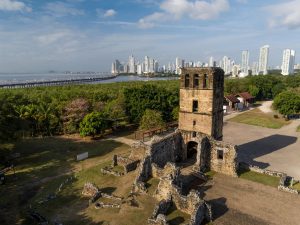The history of Panama is as deep as any in the region and learning about it is an important aspect of relocating to Panama or starting a business there. Panama is a small country with a long and complex history, stretching back to the dawn of civilization. Long before the arrival of Europeans, Indigenous people lived in what is now known as Panama for centuries, and today many of these cultures continue to shape modern Panamanian society. In the following blog post, we’ll give a brief overview of the most prominent parts of each of the periods in Panama’s history so you’ll have a basic understanding and can stay better informed.
The History of Panama in Periods
Pre-colonial period:
The earliest evidence of human habitation in and around Panama dates back to 10 000 BC when nomadic hunter-gatherer tribes inhabited the region. These early settlers hunted, fished, and gathered fruits and vegetables from the land and sea while also constructing villages along riverbanks and coasts. This era had little human imprint, however, it was very significant in the evolution of the human species in the region, as well as the vast diverse wildlife that would soon exist there.
By 800 AD, there were more than 50 distinct Indigenous nations living in this part of Central America, each with its own languages, customs, religions, and social structures. Of these peoples, two major empires – The Mayan Empire in Mesoamerica (Mexico & Guatemala) and The Chibchan Empire further south –are believed to have had a significant influence on the development of Panamanian culture. These empires built monumental cities and monuments, but their legacy is perhaps more noteworthy in the culture of pre-colonial Panama.
Colonial period:
In 1501 Spanish explorer Rodrigo de Bastidas arrived in what is now known as Panama City – marking Spain’s first foray into colonizing Central America. Soon after other Spaniards followed suit establishing settlements throughout the region including El Río Chagres which served as a gateway for Spanish treasure ships headed for Europe. The most famous of all conquistadors who arrived in Panama was, of course, Vasco Núñez de Balboa who, in 1513, was the first European to cross the isthmus and see the Pacific Ocean. Balboa’s name is still an integral and iconic part of Panama, with a city and the nation’s currency named after him.
This colonial period lasted over 300 years until 1821 when Spanish control was abolished following the region’s independence from Spain during Latin America’s Wars of Independence. Once free from colonial rule several countries formed out of what had been New Granada (modern-day Colombia) including Ecuador and Venezuela as well as present-day Panama which became an independent nation on November 3rd, 1903. Panama was part of the United States-backed Gran Colombia until 1903 when it was declared an independent nation. The declaration of this independence was just shortly before the United States become involved in building the Panama Canal, which was no coincidence.
Modern Period:
In 1904 the United States built a canal across Panama at the invitation of its newly independent government thus giving birth to one of the world’s most important waterways, The Panama Canal, which is still in operation today over 100 years later! In 1977 dictator Manuel Noriega rose to power ushering in one of the darkest periods in Panamanian history until his eventual overthrow by US forces in 1989. Before this overthrow, in the 1970s, Panama’s President Omar Trujillo and US President Jimmy Carter signed a treaty that allowed the United States to retain control of the canal until 1999.
This agreement effectively granted Panama greater control over its economy, which has since boomed, allowing the country for over 20 years to grow and flourished. Since then, many other economic reforms have helped strengthen Panama’s economy significantly paving way for its reintegration into Latin American markets. Today, modern-day Panama continues to develop at an impressive rate due to its strategic geographic position between North and South America. This put Panama on the map as more of a global economic and trading power, with an economy that includes a thriving tourism sector, an important financial center, and an increasingly diversified services economy.
The Future of Panama
Panama’s history is long and varied, from pre-colonial Indigenous culture to Spanish conquest to modern-day economic growth. It is a history that has been shaped by the people of Panama over centuries but also by events beyond its control. The outlook for Panama’s future is bright, as the country continues to develop and expand its economy. With the vibrant history of Panama in mind, it is exciting to consider what the future will bring for this small but significant nation.
To learn more about investing in Panama, Panama tourism, relocating to Panama, or if you’re just curious to take a deeper dive into the history of Panama, feel free to reach out to us here. We’d be happy to assist you with any information you need.
